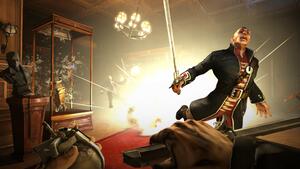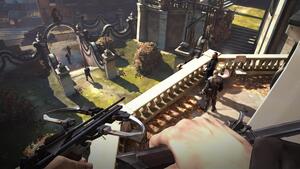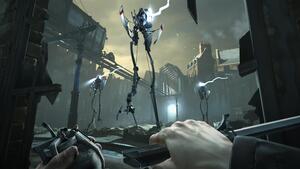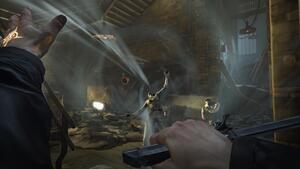
We didn't know much about Dishonored, Arkane Studios’ new game, until its first promotional trailer landed a week ago, sending the cyber-masses into feverish speculation. A few things about its concept and storyline could be gleaned from the teaser film: players will assume the role of Corvo, an Imperial bodyguard accused of murdering the Empress, who is granted supernatural powers to exact revenge on the people who framed him. The trailer, in all its stealth and roof-hopping glory, promised action aplenty but showed no in-game footage, although confidence hit a high when it was revealed that one of the men behind Dishonored is Harvey Smith, one of the lead designers in System Shock and Deus Ex, arguably two of the most revolutionary first-person adventure games ever.
It's mid-April and Push Square is in London where Smith and some of his colleagues are introducing Dishonored’s main mechanics to the press for the first time by demoing two of its stages. Raphaël Colantonio, Arkane’s president and co-creative director, runs us through the basics of the game, explaining how you progress by completing different missions (generally of the murdering kind), aided by superpowers that are steadily granted or earned by collecting runes. The gamut of abilities ranges from your standard X-rays, called Dark Vision here, to a neat possession feature that allows Corvo to occupy any other bodies (human or not) in a manner not entirely dissimilar to cult GameCube title Geist. Colantonio shows how this can be put into practice in the first demo stage, a break-in of the Golden Cat bathhouse, where players are given the option to get inside the building via its rooftop entrance, smashing a window, possessing an unsuspecting enemy or — why not? — taking the form of a fish from the canal nearby to enter the bathhouse through its water supply network.

While it doesn’t come as a surprise that a game developed by some of the most capable minds in the first-person adventure genre has an organic, structure-free approach to its in-game objectives, Smith confirms it'll be an episodic adventure in the tradition of classic gaming design, claiming it's crammed with full fat goodness from beginning to end of each stage and none of the watered-down filler of some of the open-ended affairs of late. He reiterates that extreme care has been taken to hand players as much freedom as possible within the constraints of the self-contained missions and the linear progression of the story. Non-playable characters also inhabit the world without relying on the player’s presence, with conversations and events carrying on regardless of whether Corvo is in the vicinity or not.
Tears in the rain
It’s fitting that Arkane Studios has chosen to introduce Dishonored to the press on a rainy London afternoon, as so much of the game has been inspired by this city and its weather. Sébastien Mitton, art director at Arkane, and Viktor Antonov, visual design director at mother company Zenimax, explain how the genesis of Dishonored’s visual design began taking shape after a visit to the British capital. Although science fiction totems such as Fritz Lang’s Metropolis and Blade Runner were obvious points of reference, it was the East End of London and more specifically the Docklands area that provided them with an original frame of reference. Its tall, faceted warehouses interconnected by suspended bridges inspired the game's killer rooftop descents into enemies, while the sharp church towers, chimneys and watchtowers perforating the grey skyline hark back to the very specific era of 1666 plague-infested London.

Dishonored mirrors the real-life bubonic epidemic in its storyline, particularly in the Flooded Area, full of quarantined buildings draped in sheets, vicious rats and debris all around. With fewer opportunities for stealth due to a ubiquitous presence of enemy units, combat takes centre stage here, and it’s a relief to see Dishonored stay true to its action game roots rather than going full-on Halo. There’s a decent array of fighting options without relying too heavily on your average guns and grenades, from a range of blades to Corvo’s bare hands, aided by his supernatural powers: teleporting behind enemies to snap their necks or slit their throats in one swift Tenchu-style flourish is one of the game’s signature moves, but the absolute top trump has to be possessing enemies to lead them to an untimely death. In the words of Colantonio, players are encouraged to “get creative” with the different abilities at their disposal, telling the story of how a tester found a way of latching a landmine onto a rat, then proceeded to possess it and lead it towards an unsuspecting enemy for an explosive surprise. Dishonored’s tool box seems to almost rival The Legend of Zelda in its versatility — even a very futuristic crossbow makes an appearance — but the focus here is less on terrain interaction and more on gory combat, dismembering enemies and smashing heads as streams of blood flow generously.
Character building
In a market saturated by sequels and identikit games, new IPs like Dishonored must fight for shelf space with a strong and unique identity, something Viktor admits is of paramount importance when laying the groundwork for an atmospheric universe that may spawn future sequels. To this effect, Arkane has employed artists with previous experience illustrating pirates books to achieve a very distinctive, hand-drawn look that tells a story on first glance. The features of the different characters reflect their personalities and status in the very structured city of Dunwall: not only clothes, hats, haircuts, but also body builds, head shapes, noses, jaws and other facial attributes help the characterisation without verging into obvious clichés or cartoony territory thanks to the use of painted textures in the game. Dishonored’s suggestive style and striking lightning stand out in a world of drab browns and photorealistic obsession — Viktor acknowledges lifelike rendering and animation are popular choices for big IPs nowadays, but they find them still too underdeveloped and restrictive in a way the impressionistic nature of painted textures is not, thanks to its more stylised and cleaner read. As a result, Dishonored has a striking visual flare, rarely present in gaming, halfway between the dreamlike mise-en-scene of certain Terry Gilliam films and the dishevelled steam-punk look of Jean-Pierre Jeunet’s The City of Lost Children.

This art direction is a far cry from the academically faithful classicism of Assassin’s Creed, the supreme assassin simulator series these days and a constant comparison to Dishonored since its unveiling. But while it’s possible that Arkane Studios may be trying to ride on the wave of success of Ubisoft’s franchise, it’s far more likely that Smith had in mind the seminal and underrated Thief series, a trilogy of first-person stealth action games developed by Looking Glass and later Ion Storm, two companies at the epicentre of the Texan developer 90s revolution in which Smith and plenty others at Arkane cut their teeth (he is thanked in the credits of Thief: Deadly Shadows, which shares some interesting similarities in plot and execution with Dishonored.)
With the weight of an in-house custom version of the Unreal Engine 3 and two years of development by an experienced team behind it, Dishonored looks set to step the stealth genre one notch up the fantasy scale. Whether the blend will catch on with the general public remains a mystery as impenetrable as some of the Lovecraftian elements of the plot, but we're only a few months short of finding out.
Comments 0
Wow, no comments yet... why not be the first?
Leave A Comment
Hold on there, you need to login to post a comment...